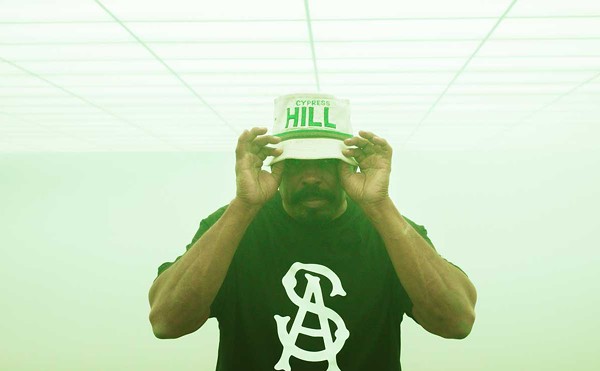Love It to Death
Alice Cooper
Straight/Warner Brothers, 1971
Detroit, fall 1970. Alice Cooper’s fist-jacking “I’m Eighteen” begins to rattle lockers in high-school hallways. The Detroit kids, it seemed, knew a rallying call when they heard one. So much so that they flooded Windsor, Ontario’s AM radio powerhouse CKLW with thousands of requests. So many phone calls, in fact, that the radio station was forced to forgo Canadian Radio-television and Telecommunications Commission policy — one that guaranteed Canadian artists 50 percent of air time — and played “I’m Eighteen” over and over and over and over.
CKLW was the first radio station anywhere to add “I’m Eighteen” to its playlist. By February 1971, it was No. 15 on the CKLW chart. Soon hundreds of other stations in North America picked up on it. Months later “I’m Eighteen” peaked on the U.S. pop chart at No. 18. The album, Love It to Death spent nearly 40 weeks in the Billboard top 200. The Detroit-based five-piece band would soon make the world gasp.
“Well, that was the shock of our life,” recalls the Detroit-born Cooper during a recent phone interview. “You know, we’d listen to CKLW just going down to the store. It was the biggest radio station in five states. You’d be listening to Simon and Garfunkel, and you’d be listening to the Supremes, and you’d be listening to the Temptations and the Beatles, and then all of a sudden: ‘And now the most requested song of the hour … “Eighteen.”’ and we’d go ‘What!’ I mean Iggy or the MC5 never got played on CKLW. We were the first ones out of Detroit to get national airplay like that.”
By early 1971, flower power had all but wilted. The United States was conducting large-scale bombing raids against North Vietnam. Jim Morrison died that year. Jimi and Janis were already gone. The Stooges had sparked the American fringes but failed to ignite a nation. It had become increasingly apparent that suburban American kids needed a rock ’n’ roll savior.
Love It to Death (the band’s third album and its first on a major label) was so welcome, so necessary, and so right. It was a climbing-down-the-drain waxwork of teen torment and hope. It was all about youthful confusion and ache. About being young with a slippery grip on reality. Yet the spare, almost severe sounding pop thud of the single “I’m Eighteen” is thematically optimistic. Working on numerous levels, the tune never patronizes the listener with bogus teen angst or strut.
I got a baby’s brain and an
old man’s heart
Took 18 years to get this far
Don’t always know what
I’m talking about
Feels like I’m living in the
middle of doubt
I’m a boy and I’m a man,
I’m 18 and I like it.
The stark black-and-white album jacket itself was purely anti-flower, and Cooper’s Alex Milkplus-ish eyes gatefold is disturbingly dark. Love It to Death inspired extreme negative reaction and made the band (Cooper, guitarists Glen Buxton and Michael Bruce, bassist Dennis Dunaway, and drummer Neal Smith) a nadir in the eyes of parents, priests, rabbis and teachers the world over.
The record was a rat-haired mess of A Clockwork Orange, Warholian androgyny, Yardbirds-ready garage rock, and good old-fashioned Dadaism. A precise amalgamation of glittery images, tirade, and spectacle that nailed the hippie coffin shut and ushered in a new era of rock ’n’ roll.
Cooper himself took Morrison and Jagger to task, bumped the rock star aesthetic up to the next level with a mix of lissome, base gyration that was at once lovely, grotesque and appalling. On Love It to Death he looked eerily like a peepshow Janis Joplin. And the lyrics — why else would Dylan say publicly that Alice Cooper was an underrated lyricist?
The album took Alice’s creepy glam straight to the jugular of American teen angst with a gusto unmatched by an American rock ’n’ roll band either before or after. The record is so very Detroit. Cooper says the band was right at home living in Detroit and Love It to Death is a reflection of the city.
Love It to Death was conceived and written on a beat ranch in Pontiac.
“It was just a dumpy little farm,” Cooper recalls in his patented nasal deadpan. “You wouldn’t take your family there, maybe you’d take your band there but not your family. [Guitarist] Glen [Buxton] slept in the living room ... “We had a barn out in the back and the barn is where we did all the rehearsing and all the writing for Love It to Death, eight or nine hours a day. We used to hang Budweiser cans from strings, and we spent so much time out there shooting the cans with BB guns. The guy who could split the Bud can in half with BBs and make the can fall on the ground would win.”
Cooper credits then-unknown Canadian producer Bob Ezrin as the musical engine that pulled the group to its next stop. Ezrin performed surgery on the songs, stripping them to bare essentials and reconstructing them.
“With Bob Ezrin, he brought this classical influence and we fought him tooth and nail,” remembers Cooper, laughing. “Every time he’d say, ‘We’re gonna take this guitar out and put a cello in’ we’d go, ‘Not on our record you’re not.’ And he’d say, ‘We’re gonna make this bass line follow the piano. ’We’d go, ‘Who said there is gonna be a piano!’”
The band wanted Love It to Death to be simply a guitar album, a Detroit-sounding rock ’n’ roll record.
“We didn’t want to hear anything about a horn or a keyboard, we just didn’t want to hear about it,” Cooper continues. “And then we’d rehearse and play it back and listen to it, and we’d like it. It was like dragging and kicking our legs into some new evolution of Alice Cooper. ’Cause we were just so comfortable being a psychedelic Yardbirds rip-off, which is really what we were.
“We loved that [the first Stooges] record,” he continues. “I mean there were very few bands I actually liked. But, when I saw the Stooges, I was like, ‘What was that!’ There was something really street about them. When Iggy came out, I mean, I always said that the only band I never wanted to go on after is Iggy and the Stooges. I did so many shows with Iggy, and I knew we were bigger than they were, but it was so hard to get the audience back. He would just steal the audience every time and, we had to go back and get them again [laughs]. We got them in a whole different way. But, jeez, try and get an audience after Iggy. … He would just wear them out!”
What was brilliant is how the Alice Cooper Group unearthed a reality through a disdain of pop culture, and the band did it within the context of misleadingly perverse pop songs. Love It to Death had the songwriting, from the narrative-driven “Ballad of Dwight Fry” to the cheery, album-closing “Sun Arise.”
It wasn’t just rock ’n’ roll, it was a purity of low-rent boys playing high-art rock theater minus the art-school pomp. The band incorporated guillotines and gallows, snakes and hacked-up dolls into its show. And Love It to Death bastardized American pop culture and burped it back into the faces of an unsuspecting and inert public. Nobody had seen anything like it.
The album brought spirit and guts into staid pop charts that were rife with aging bong-loaders in jeans, bare feet and flower patches.
Love It to Death wasn’t the Alice Cooper Group’s zenith but it was the defining moment for the decades of rock ’n’ roll to follow, one that blazed a trail for the likes of Bowie, Mott the Hoople, New York Dolls, Kiss, Sex Pistols, Mötely Crüe, Boy George, Marilyn Manson and so on.
“The fact is, is if you call what I have a musical career,” writes Johnny Rotten in the booklet that accompanies the Alice Cooper box set, “it all started with me miming to ‘I’m Eighteen’ on a jukebox.”
“When people ask me what album is my favorite I never say that Love It to Death is my favorite,” Cooper says. “No, I say it is the most definitive. …”
Love It to Death’s “Is It My Body” foreshadowed ensuing years for Alice Cooper, a band and a guy misinterpreted as glitter over substance. The song asks, “Have you got the time to find out who I really am?”
Return to the introduction for this special collection of music stories, where you'll find links to the other nine records on our list of Detroit discs that shook the world.
Brian Smith is Metro Times’ music editor. E-mail him at [email protected]




